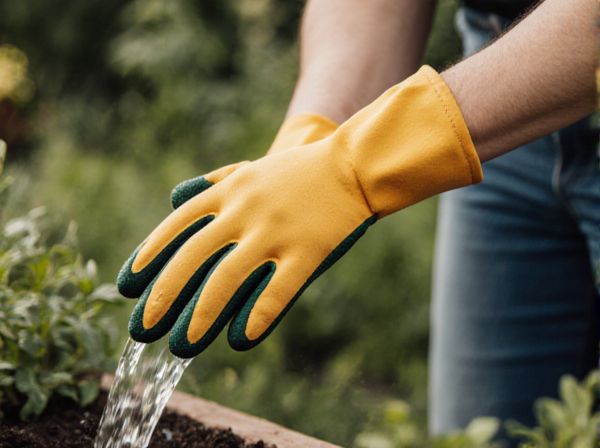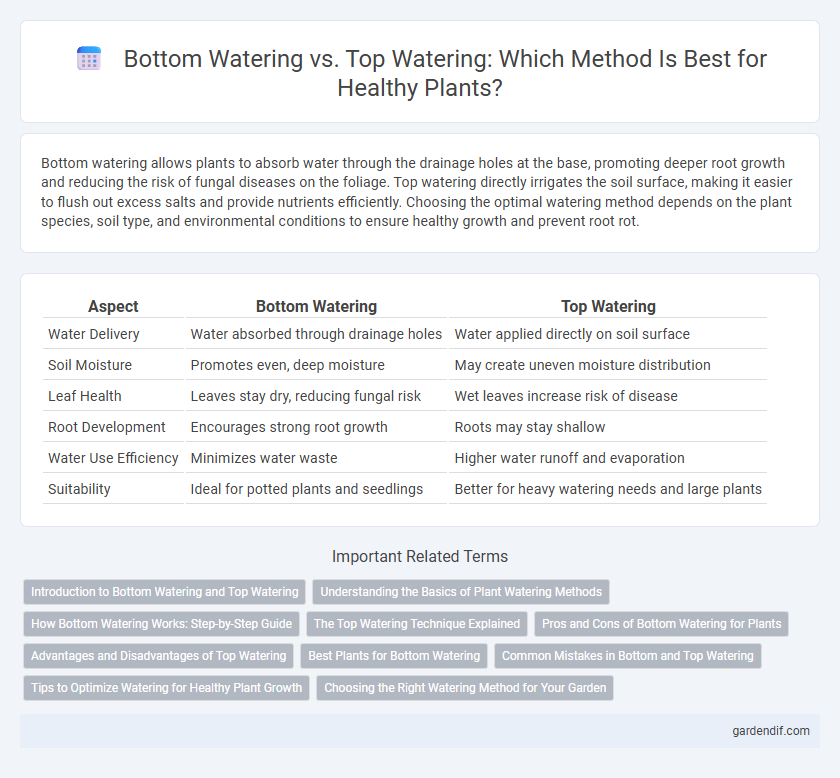
Bottom watering vs Top watering Illustration
Bottom watering allows plants to absorb water through the drainage holes at the base, promoting deeper root growth and reducing the risk of fungal diseases on the foliage. Top watering directly irrigates the soil surface, making it easier to flush out excess salts and provide nutrients efficiently. Choosing the optimal watering method depends on the plant species, soil type, and environmental conditions to ensure healthy growth and prevent root rot.
Table of Comparison
| Aspect | Bottom Watering | Top Watering |
|---|---|---|
| Water Delivery | Water absorbed through drainage holes | Water applied directly on soil surface |
| Soil Moisture | Promotes even, deep moisture | May create uneven moisture distribution |
| Leaf Health | Leaves stay dry, reducing fungal risk | Wet leaves increase risk of disease |
| Root Development | Encourages strong root growth | Roots may stay shallow |
| Water Use Efficiency | Minimizes water waste | Higher water runoff and evaporation |
| Suitability | Ideal for potted plants and seedlings | Better for heavy watering needs and large plants |
Introduction to Bottom Watering and Top Watering
Bottom watering involves supplying water directly to the soil through a reservoir or tray, allowing roots to absorb moisture efficiently and reducing the risk of fungal diseases caused by wet foliage. Top watering, the traditional method, delivers water from above, simulating natural rainfall but may cause soil erosion and uneven moisture distribution if not carefully managed. Understanding the advantages and challenges of both techniques helps optimize hydration for healthier plant growth and root development.
Understanding the Basics of Plant Watering Methods
Bottom watering involves supplying water directly to the soil through the drainage holes, allowing roots to absorb moisture efficiently and reducing the risk of overwatering or fungal diseases on leaves. Top watering, the traditional method, delivers water from above, promoting even soil moisture distribution but increasing the chance of water runoff and leaf damage. Choosing the appropriate watering technique depends on plant species, soil type, and environmental conditions to optimize growth and prevent root rot.
How Bottom Watering Works: Step-by-Step Guide
Bottom watering involves placing a plant's pot in a shallow container filled with water, allowing the soil to absorb moisture through drainage holes by capillary action. This method ensures even hydration at the root zone while minimizing surface water evaporation and fungal growth. Plants typically need to sit in the water for 10 to 30 minutes, depending on soil type and pot size, to achieve optimal moisture levels.
The Top Watering Technique Explained
Top watering involves applying water directly to the soil surface, allowing it to soak down to the plant roots. This method promotes even moisture distribution and is suitable for most houseplants, but it can sometimes lead to water runoff or soil compaction. Regular monitoring ensures soil remains consistently moist without overwatering, which helps prevent root rot and encourages healthy plant growth.
Pros and Cons of Bottom Watering for Plants
Bottom watering helps prevent overwatering and reduces the risk of fungal diseases by allowing plants to absorb water through the drainage holes. It promotes deeper root growth and ensures even moisture distribution, but may lead to salt buildup in the soil over time and requires careful monitoring to avoid underwatering. This method is especially beneficial for potted plants and seedlings that are sensitive to wet foliage.
Advantages and Disadvantages of Top Watering
Top watering allows precise control over water distribution, reducing the risk of overwatering and minimizing water waste. It can help flush salts and minerals from the soil surface, preventing root damage and promoting healthier plant growth. However, top watering may cause soil erosion, encourage fungal diseases by keeping leaves wet, and lead to uneven water absorption in deeply rooted plants.
Best Plants for Bottom Watering
Bottom watering is ideal for moisture-loving plants such as African violets, ferns, and orchids, which absorb water efficiently through their roots without wetting their foliage. This method minimizes the risk of fungal diseases and leaf rot by keeping leaves dry, promoting healthier growth. Succulents and cacti, however, are better suited for top watering due to their preference for drier soil conditions.
Common Mistakes in Bottom and Top Watering
Common mistakes in bottom watering include using water that is too cold or allowing plants to sit in standing water for extended periods, leading to root rot and fungal issues. In top watering, overwatering and water splashing on foliage can promote mold growth and attract pests. Both methods require careful attention to moisture levels and plant needs to avoid stress and disease.
Tips to Optimize Watering for Healthy Plant Growth
Bottom watering ensures roots absorb moisture efficiently by allowing water to be drawn up through the drainage holes, reducing the risk of overwatering and fungal diseases. Top watering remains useful for flushing out excess salts from soil and providing moisture to leaves, but it requires careful monitoring to prevent waterlogging. To optimize watering, combine both methods by bottom watering regularly while occasionally top watering, and always verify soil moisture with a moisture meter to maintain healthy plant growth.
Choosing the Right Watering Method for Your Garden
Bottom watering allows plants to absorb water directly through the roots, promoting healthier root growth and reducing the risk of fungal diseases on leaves. Top watering provides immediate hydration to the entire plant and soil surface, making it easier to flush out excess salts and maintain humidity. Selecting the optimal watering method depends on plant species, soil type, and environmental conditions to ensure efficient water use and prevent common issues like root rot or leaf mildew.
Bottom watering vs Top watering Infographic

 gardendif.com
gardendif.com